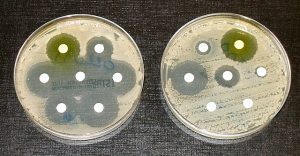1.2.4 Multi-Drug Resistant Organisms
The term multidrug-resistant organism (MDRO) refers to a germ, sometimes called a “superbug,” that is resistant to many antibiotics. Antibiotics are medicines that are prescribed to treat infections caused by bacteria.
Many antibiotics will not be successful in treating MDRO infections without using a second antibiotic at the same time. That is what is meant by the MDRO being resistant to antibiotics. Research points to the overuse of prescriptions for antibiotics in the past as a significant cause of the growing MDRO issue.
Common examples of MDRO’s include:
- Enterobacteriaceae, carbapenem-resistant (ESBL-producing)
- Staphylococcus aureus, methicillin-resistant (MRSA)
- Enterococcus faecium, vancomycin-resistant (VRE)
- Carbapenemase-producing Enterobacteriaceae (CRE)
Go Deeper
Research the symptoms of the infections listed above using the WHO website. To learn more about how antibiotic-resistant micro-organisms come to exist and spread, view this CDC infographic.
The World Health Organization has identified that hand hygiene is effective in reducing the occurrence of these MDRO’s.

Media Attributions
- Dr Graham Beards at en.wikipedia, CC BY-SA 4.0 , via Wikimedia Commons

